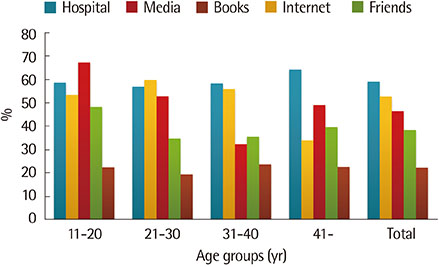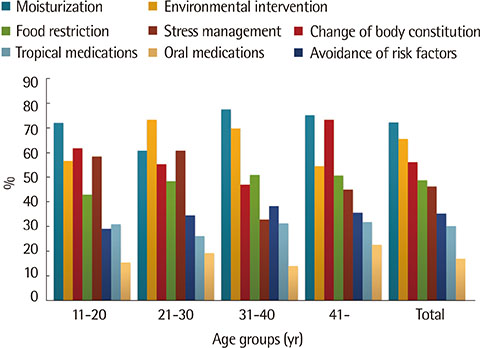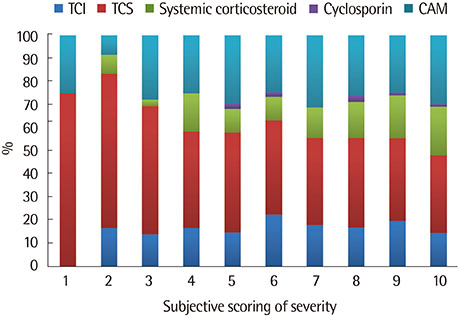Allergy Asthma Respir Dis.
2016 Jul;4(4):271-275. 10.4168/aard.2016.4.4.271.
Multicenter questionnaires on the current management of atopic dermatitis in Korea
- Affiliations
-
- 1Department of Dermatology, Institute of Human-Environment Interface Biology, Seoul National University College of Medicine, Seoul, Korea.
- 2Department of Internal Medicine, Sungkyunkwan University School of Medicine, Seoul, Korea.
- 3Department of Pediatrics, Wonkwang University Sanbon Hospital, Wonkwang University School of Medicine, Gunpo, Korea.
- 4Department of Pediatrics, Hanyang University Guri Hospital, Hanyang University College of Medicine, Guri, Korea.
- 5Department of Pediatrics, Incheon Medical Center, Incheon, Korea.
- 6Department of Pediatrics, University of Ulsan College of Medicine, Seoul, Korea.
- 7Department of Pediatrics, Hallym University Sacred Heart Hospital, Hallym University College of Medicine, Anyang, Korea.
- 8Department of Pediatrics, Soonchunhyang University Cheonan Hospital, Soonchunhyang University College of Medicine, Cheonan, Korea.
- 9Department of Allergy and Rheumatology, Ajou University School of Medicine, Suwon, Korea.
- 10Department of Pediatrics, Seoul Medical Center, Seoul, Korea. hyyum@hanmail.net
- KMID: 2346756
- DOI: http://doi.org/10.4168/aard.2016.4.4.271
Abstract
- PURPOSE
The effective management of atopic dermatitis (AD) adjusted to individual clinical courses and demands can be challenging to both patients and physicians. Understanding of actual situations, experienced and perceived by patients with AD and their caregivers, is essential to improve clinical outcomes and satisfaction in real practice.
METHODS
This multicenter survey was conducted in patients with AD or their caregivers from 9 centers with questionnaires on diagnosis and management of AD.
RESULTS
A total of 324 patients and caregivers participated in the study. Most of the AD cases were initially diagnosed by physicians (80.6%), followed by self-diagnosis. Patients and caregivers thought that allergic substances, such as house dust mites, food, and pollutants, are responsible for AD development; moisturization, environmental control, and improvement of the body constitution are important for AD management. Allergy tests were performed in 194 patients (59.9%), but allergen avoidance strategy was instructed in only 81 subjects (41.8%). Major topical medications were steroids (81.8%) and topical immunomodulators (34.3%), while systemic medications were steroids (42.6%), antihistamines (36.4%), and cyclosporins (2.8%). One hundred eighty-one subjects (55.9%) had received complementary alternative medicine, including Oriental medicine. Many subjects desired to receive individualized management, use of specialized institutions for AD as well as evidence-based, effective, sustainable treatment.
CONCLUSION
Our findings suggest that there may still be an unmet need for patients with AD in real practice. Personalized, evidencebased, and multidisciplinary approaches, including patient education, should be implemented for good outcomes.
Keyword
MeSH Terms
-
Body Constitution
Caregivers
Complementary Therapies
Cyclosporine
Cyclosporins
Dermatitis, Atopic*
Diagnosis
Histamine Antagonists
Humans
Hypersensitivity
Immunologic Factors
Korea*
Medicine, East Asian Traditional
Patient Education as Topic
Pyroglyphidae
Steroids
Cyclosporine
Cyclosporins
Histamine Antagonists
Immunologic Factors
Steroids
Figure
Cited by 1 articles
-
Current Management of Moderate-to-Severe Atopic Dermatitis: A Survey of Allergists, Pediatric Allergists and Dermatologists in Korea
Hye Yung Yum, Hyun Hee Kim, Hyun Jung Kim, Woo Kyung Kim, So-Yeon Lee, Kapsok Li, Dong Hun Lee,
Allergy Asthma Immunol Res. 2018;10(3):253-259. doi: 10.4168/aair.2018.10.3.253.
Reference
-
1. Johansson SG, Hourihane JO, Bousquet J, Bruijnzeel-Koomen C, Dreborg S, Haahtela T, et al. A revised nomenclature for allergy. An EAACI position statement from the EAACI nomenclature task force. Allergy. 2001; 56:813–824.
Article2. Hanifin JM, Reed ML. Eczema Prevalence and Impact Working Group. A population-based survey of eczema prevalence in the United States. Dermatitis. 2007; 18:82–91.
Article3. Schneider L, Tilles S, Lio P, Boguniewicz M, Beck L, LeBovidge J, et al. Atopic dermatitis: a practice parameter update 2012. J Allergy Clin Immunol. 2013; 131:295–299.e1-27.4. Park JS, Kim BJ, Park Y, Lee SY, Kim WK, Kim JE, et al. KAAACI Work Group report on the treatment of severe/recalcitrant atopic dermatitis. Korean J Asthma Allergy Clin Immunol. 2010; 30:255–270.5. Proudfoot LE, Powell AM, Ayis S, Barbarot S, Baselga Torres E, Deleuran M, et al. The European TREatment of severe Atopic eczema in children Taskforce (TREAT) survey. Br J Dermatol. 2013; 169:901–909.
Article6. Kim HB, Cho YJ, Yoo KH, Kim DY, Kim J, Kim H, et al. Survey on the management of atopic dermatitis. Korean J Asthma Allergy Clin Immunol. 2012; 32:16–20.7. Park Y. Status of clinical practice on diagnosis and management of atopic dermatitis in Korea: a questionnaire survey of physicians. Allergy Asthma Respir Dis. 2013; 1:257–265.
Article8. Barbarot S, Bernier C, Deleuran M, De Raeve L, Eichenfield L, El Hachem M, et al. Therapeutic patient education in children with atopic dermatitis: position paper on objectives and recommendations. Pediatr Dermatol. 2013; 30:199–206.
Article9. Rubel D, Thirumoorthy T, Soebaryo RW, Weng SC, Gabriel TM, Villafuerte LL, et al. Consensus guidelines for the management of atopic dermatitis: an Asia-Pacific perspective. J Dermatol. 2013; 40:160–171.
Article10. Kim JE, Lee YB, Lee JH, Kim HS, Lee KH, Park YM, et al. Disease awareness and management behavior of patients with atopic dermatitis: a questionnaire survey of 313 patients. Ann Dermatol. 2015; 27:40–47.
Article11. Cho SE, Jeon JE, Cho H, Son DK, Kim HO, Lee SH, et al. Psychological Intervention in an integrated health care service for children with atopic dermatitis. Korean J Asthma Allergy Clin Immunol. 2010; 30:100–109.12. Segal AO, Ellis AK, Kim HL. CSACI position statement: safety of topical calcineurin inhibitors in the management of atopic dermatitis in children and adults. Allergy Asthma Clin Immunol. 2013; 9:24.
Article13. Saavedra JM, Boguniewicz M, Chamlin S, Lake A, Nedorost S, Czerkies LA, et al. Patterns of clinical management of atopic dermatitis in infants and toddlers: a survey of three physician specialties in the United States. J Pediatr. 2013; 163:1747–1753.
Article14. Mohan GC, Lio PA. Comparison of dermatology and allergy guidelines for atopic dermatitis management. JAMA Dermatol. 2015; 151:1009–1013.
Article
- Full Text Links
- Actions
-
Cited
- CITED
-
- Close
- Share
- Similar articles
-
- Measurement of Atopic Dermatitis Disability
- Therapeutic approach to atopic dermatitis in children
- Current Status in Management of Children with Atopic Dermatitis and Knowledge and Practice of Preschool Teachers
- Serum IgE Level in Patients of Atopic Dermatitis and Atopic Dermatitis with Molluscum Contagiosum
- Nipple Involvement in Atopic Dermatitis: Report of 3 cases




